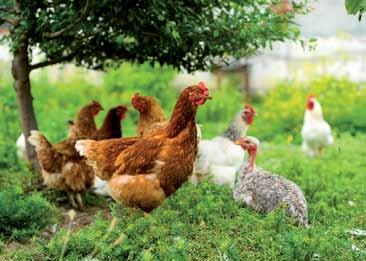
5 minute read
global briefs
Stealth Mode
Blackest Fish in the Sea Aid Scientific Research Scientists from Duke University and the Smithsonian National Museum of Natural History have found that the skin of 16 species of deep-sea fish absorbs more than 99.95 percent of the light that hits them. As published in Current Biology, Dr. Karen Osborn co-led the research that discovered the extraordinary properties while attempting to photograph specimens. Even using cutting-edge equipment, she could not see any detail. “It didn’t matter how you set up the camera or lighting; [the fish] just sucked up all the light,” she tells BBC Science Focus. The source of the ultra-black color is melamin which is distributed within melanosomes that are densely packed into cells on the fish skin. Because of the unique shape and arrangement of these melanosomes, incoming light is redirected toward another cell to absorb it. In the deep-sea environment in which they live, even the smallest amount of reflected light can attract predators, so this form of camouflage improves their chances of survival. Some scientists believe it is possible to make similar ultra-black substances for sensitive optical equipment.
Advertisement
Short Circuit
Electronic Waste is Out of Control A partnership formed in 2017 between the United Nations International Telecommunication Union, the International Solid Waste Association and other groups to track the accumulation of electronic debris has reported via the publication Global E-Waste Monitor 2020 that a record 53.6 million metric tons of electronics were discarded in 2019 and could likely increase to 74.7 million tons per year by 2030. E-waste includes battery-powered and plug-in laptop computers, smartphones and televisions. Not only are people using more consumer electronics, they are not doing a good job of recycling them safely. The report found that of the e-waste generated in 2019, only 9.3 million tons, or 17.4 percent, were recycled. Cadmium and mercury are conspicuous sources of pollution from these devices, as are refrigerant chemicals like chlorofluorocarbons and hydrochlorofluorocarbons that can leach into the environment. Plastic waste is another concern. The report states that e-waste contains so many valuable recoverable metals such as iron, copper and gold that it represents a prime opportunity to reclaim these raw materials instead of mining them anew.
Corporate Hero
Apple Seeks 2030 Carbon Neutrality Apple, Inc., the maker of the iPhone, iPad and Mac computers, has committed to becoming 100 percent carbon neutral overall, from its supply chain to retail outlets, by 2030. The goal is to achieve a zero net climate impact. According to
BBC Science Focus Magazine, CEO Tim Cook says, “Businesses have a profound opportunity to help build a more sustainable future, one born of our common concern for the planet we share. The innovations powering our environmental journey are not only good for the planet, they’ve helped us make our products more energy-efficient and bring new sources of clean energy online around the world. Climate action can be the foundation for a new era of innovative potential, job creation and durable economic growth. With our commitment to carbon neutrality, we hope to be a ripple in the pond that creates a much larger change.” If successful, the 10-year plan will reduce carbon emissions by 75 percent and develop solutions such as the use of low carbon and recycled materials to achieve the other 25 percent.

Baby Boo-Boo
Falling Fertility Rate Threatens World Stability As reported in The Lancet, researchers at the University of Washington Institute for Health Metrics and Evaluation showed the global total fertility rate (TFR) nearly halved from 1950 levels, when women had an average of 4.7 children each, to 2.4 in 2017. The study indicates it could fall below 1.7 by the turn of the century. As a result, global population may peak at 9.7 billion around 2064 before falling to 8.8 billion by 2100. Some nations will also age dramatically, with as many people becoming senior citizens as those being born. If the fertility rate falls below a ratio of about two to one, then the size of the population starts to fall. Funded by the Bill & Melinda Gates Foundation, the report states, “Our findings suggest that continued trends in female educational attainment and access to contraception will hasten declines in fertility and slow population growth. A sustained TFR lower than the replacement level in many countries, including China and India, would have economic, social, environmental and geopolitical consequences. Policy options to adapt to continued low fertility while sustaining and enhancing female reproductive health will be crucial in the years to come.”
Oarweed Odyssey
Scottish Kelp Provides Clues to Climate Change The BBC reports that experts from Heriot-Watt University, in Orkney, Scotland, have discovered kelp off the coasts of Scotland, Ireland and France that has survived for 16,000 years since the last ice age. Analyzing the genetic composition of oarweed from 14 areas across the northern Atlantic Ocean, they found three distinct genetic clusters and hope the discovery will show how marine plant life survives extreme changes in climate. Their findings were published in the European Journal of Phycology. Marine ecologist Dr. Andrew Want says that oarweed populations from Kirkwall Bay managed to hang on and survive amid dramatic changes: “As the ice sheets retreated from northern European shorelines at the end of the most recent ice age, oarweed distribution followed and recolonized [in] the higher latitudes of the Atlantic. Kelp plays a critical role in the Atlantic, so it is important to understand what affects its distribution and survival over time and how sensitive it is to change.”
Molecular ecologist Dr. Joao Neiva, from Portugal’s University of Algarve Centre of Marine Sciences, says, “Our study shows how marine organisms adjust to shifting climates by migrating polewards and even across the Atlantic, when conditions are favorable.”
THE ECONOMY THRIVES WHEN EVERY PERSON THRIVES.
AT ASSETS, we believe that diversity and inclusion make our community strong and that people of all backgrounds should be equally represented in its success. This is why we’ve made it our mission to provide entrepreneurs of color and women the essential tools and resources they need to successfully launch and grow their businesses. You also have a key role to play. Together, we must change the way business is done to create an economy where everyone can prosper.
GET STARTED AT ASSETSPA.ORG
TRANSFORMING COMMUNITIES through BUSINESS

PASTURE RAISED Pork & Chicken
Humanely raised on a sustainable farm, home to heritage pigs, chickens, alpacas, angora rabbits, and goats.
“ The finest you have ever tasted.”
592 Stone Hill Road | Shoemakersville, PA 484-797-2263 | BentLimbFarm.com










